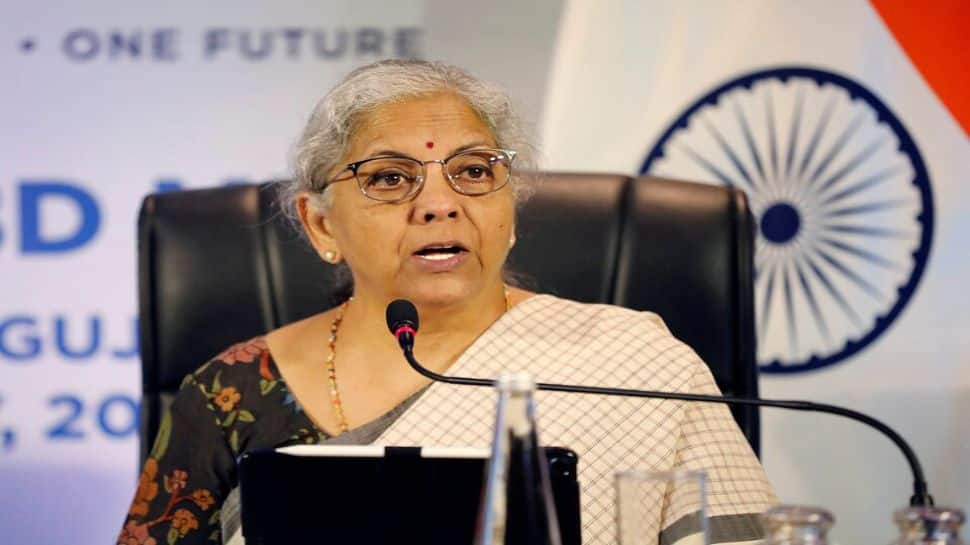Business
Eli Lilly’s obesity pill remains a viable rival to Novo’s oral Wegovy despite data that underwhelmed investors

A sign with the company logo sits outside of the headquarters of Eli Lilly in Indianapolis, Indiana, on March 17, 2024.
Scott Olson | Getty Images
Eli Lilly‘s stock is still recovering after the drugmaker released trial data earlier this month on its closely watched obesity pill that underwhelmed Wall Street.
In a key late-stage trial, Eli Lilly’s pill, orforglipron, caused less weight loss and had higher side effects than what analysts were expecting. The pill’s efficacy also appeared to come in slightly below that of Novo Nordisk‘s oral semaglutide for obesity, which showed strong data in a separate study.
Shares of Eli Lilly fell about 13% on the day the trial results were released, although they’re up about 12% since then.
But some analysts say Eli Lilly’s daily pill, if approved, could still be a viable competitor in the weight loss drug space — even if it will likely be second to enter the market. It’s a highly lucrative area that is eager for more convenient options that could ease the supply shortfalls and access hurdles created by the pricey weekly injections currently dominating it.
Analysts note that Eli Lilly’s pill could have a few advantages over the daily oral version of Novo Nordisk’s weight loss drug semaglutide, which is on track to become the first needle-free alternative for obesity to win approval in the U.S. later this year. Eli Lilly hopes to launch its pill globally “this time next year,” CEO David Ricks told CNBC in early August.
Both drugs work by mimicking a gut hormone called GLP-1 to suppress appetite and regulate blood sugar. But while Novo Nordisk’s pill is a peptide medication, orforglipron is a small-molecule drug.
That means Eli Lilly’s pill is absorbed more easily in the body and doesn’t require dietary restrictions like Novo Nordisk’s does. Orforglipron will also be easier to manufacture at scale, which is crucial as demand for obesity and diabetes injections outpaces supply.
Neither company has released prices for its respective pill, but some analysts said Eli Lilly’s drug could potentially have a lower price than Novo Nordisk’s pill. That would be a notable edge, as many health plans in the U.S. still don’t cover obesity treatments.
“It’s a little bit of an apples and oranges comparison because Novo Nordisk could have difficulty manufacturing enough of the product, given the high cost and requirements to manufacture oral semaglutide,” Leerink Partners analyst David Risinger said in an interview.
“Whereas Lilly plans to blanket the world with orforglipron, and very quickly it will generate dramatically more sales,” he continued. “It can launch globally in an extraordinary manner with lower prices and with no food intake consideration.”
Goldman Sachs analysts seem to agree, based on a note in August. They forecast daily oral pills will capture 24% share — or around $22 billion — of the 2030 global weight loss drug market, which they expect to be worth $95 billion.
The Goldman analysts said they expect Eli Lilly’s pill to have a 60% share — or roughly $13.6 billion — of the daily oral segment of the market in 2030. They expect Novo Nordisk’s oral semaglutide to have a 21% share — or around $4 billion — of that segment. The remaining 19% slice will go to other emerging pills, the analysts said.
The race to develop a more convenient obesity pill has been fraught, as companies such as Pfizer have had to scrap previous contenders and bring forward new ones. Novo Nordisk and Eli Lilly are also exploring other experimental oral drugs, along with a slate of other companies such as Viking Therapeutics, Structure Therapeutics, AstraZeneca and Roche.
In a statement, Novo Nordisk CEO Mike Doustar said “we strongly believe in the efficacy” of the oral drug. The Danish company added it will be “laser-focused on getting this product to patients without supply constraints” in the U.S.
Dr. Mihail “Misha” Zilbermint, director of endocrine hospitalists at Johns Hopkins Community Physicians, said it’s hard to crown a winner between Eli Lilly and Novo Nordisk without knowing how their respective pills will be priced and whether insurance will cover them.
“I think both of the drugs are going to be gamechangers,” he said. “When it comes to which company is going to win the game — cost is the biggest issue.”
Weight loss, side effect comparisons
It’s difficult to directly compare the results of separate clinical trials, especially as investors wait for Eli Lilly and Novo Nordisk to release the full data from their phase three studies.
Eli Lilly’s ATTAIN-1 trial also followed 3,000 patients, while Novo Nordisk’s OASIS 4 study evaluated a much smaller group of roughly 300. There are currently no studies directly comparing the two drugs, a Novo Nordisk spokesperson said.
But Novo Nordisk’s oral semaglutide appears to cause a greater level of weight loss than Eli Lilly’s pill based on the available data, said BMO Capital Markets analyst Evan Seigerman.
In the trial, the highest dose of Eli Lilly’s pill helped patients lose 12.4% of their body weight on average at 72 weeks. The pill’s weight loss was 11.2% when analyzing all patients regardless of discontinuations.
Wall Street had hoped Eli Lilly’s pill would generate weight loss of around 15%, the same level as Novo Nordisk’s blockbuster weight loss injection Wegovy. Semaglutide is the active ingredient in Wegovy and its diabetes counterpart Ozempic.
Novo Nordisk flags flutter outside its office in Bagsvaerd, on the outskirts of Copenhagen, Denmark, on July 14, 2025.
Tom Little | Reuters
Meanwhile, the 25-milligram dose of Novo Nordisk’s oral semaglutide helped patients lose up to 16.6% of their weight on average at 64 weeks, according to results from the trial presented at a medical conference in 2024. That weight loss was 13.6% when the company analyzed all patients regardless of whether they stopped the drug.
A Novo Nordisk spokesperson added that 20% of weight loss was observed in nearly one-third of patients in the trial.
Still, the slightly lower efficacy of Eli Lilly’s pill may not be significant enough to deter patients from taking it.
“For many patients, 12% is a really great number,” said Seigerman. “There’s definitely a market there” for orforglipron.
In a note earlier this month, Bank of America analysts shared a similar sentiment.
“Yes, weight loss fell a bit short, but ask 100 prescribers whether this new data will really make a difference in who they’d put on orforglipron, and our belief is the vast majority would say, ‘not really,'” they wrote, referring to Eli Lilly’s trial data.
Some investors raised concerns about the side effects and discontinuation rates in the trial of Eli Lilly’s pill. But Seigerman said the drug’s tolerability data — how well patients tolerate it — appears to be relatively in line with that of Novo Nordisk’s oral semaglutide.
About 10.3% of patients who took the highest dose of Eli Lilly’s pill — 36 milligrams — discontinued treatment due to side effects, compared with around 2.6% of those who took a placebo.
Those side effects were mainly gastrointestinal, such as nausea and vomiting, and mild to moderate in severity. An estimated 24% of those who took the highest dose of Eli Lilly’s pill reported vomiting, while 33.7% had nausea.
Leerink’s Risinger said he is watching to see how persistent those gastrointestinal issues are once Eli Lilly presents the full data.
The side effects in the trial on Novo Nordisk’s pill were mostly gastrointestinal-related: 30.9% of those who took oral semaglutide reported vomiting and 46.6% reported nausea, according to the trial results.
Johns Hopkins’ Zilbermint said it’s difficult for him to decide which one has a better safety and tolerability profile based on the available data.
Meanwhile, Seigerman pointed to a different factor “that will also matter a lot”: dietary requirements.
Food requirements, manufacturing, price
Unlike Eli Lilly’s pill, patients need to take Novo Nordisk’s oral semaglutide in the morning on an empty stomach with no more than four ounces of plain water. They’re instructed to wait 30 minutes before eating, drinking or taking other oral medicines.
Seigerman said that could be a hurdle for some patients.
For example, “if you’re a parent with kids and you have to take this drug and wait half an hour before you can drink your coffee, you’re going to drive yourself crazy, especially if you have to take this every day,” he said. “I try to think about the real-world use of these drugs in a market like this. It’s going to matter.”
Leerink’s Risinger said oral semaglutide will also be “extremely expensive to manufacture” since it is a peptide medication, and “is likely going to have to be priced higher than orforlipgron.”
A Novo Nordisk spokesperson said the pill will be made mostly in the U.S., and the company is excited about the potential the pill “provides millions of Americans living with obesity.”
“Currently, all typical launch readiness activities [for the pill] are fully underway and building momentum,” the spokesperson said. They added that over the past decade, the company has invested $24 billion in the U.S. to expand manufacturing capacity and fuel research and development. That includes investments aimed at increasing manufacturing of active pharmaceutical ingredients and capacity for the final stages of production for both current and future injectable and oral products.
Small molecules are chemically simpler and easier to produce at scale, making them generally cheaper for companies to formulate. But it is still unclear how Eli Lilly will price orforglipron.
During an earnings call in August, Eli Lilly’s Ricks said the pricing will be based on the value orforglipron brings, considering health-care savings and the comorbidities it can address.
In the note earlier this month, Goldman Sachs analysts said they expect the pill to be “priced at parity” to Eli Lilly’s tirzepatide, the active ingredient in the company’s obesity injection Zepbound and diabetes counterpart Mounjaro, which list for just over $1,000 for a month’s supply.
“They should be cheaper than injections because they are easier to produce. But it does not mean they will be cheaper,” Johns Hopkins’ Zilbermint said. “We just don’t know — for example, we don’t know how much went into research and development.”
Seigerman said commercialization strategies will also be key when the pills compete on the market.
He questioned whether Novo Nordisk will lean into the deal it recently struck with CVS‘s pharmacy benefit manager, Caremark. Under the deal, Caremark started to prioritize Novo Nordisk’s Wegovy on its standard formularies on July 1, making that weekly injection the preferred GLP-1 drug for obesity over Zepbound.
But it is unclear whether oral semaglutide could receive a similar preferential status.
Seigerman also questioned whether Eli Lilly will offer orforglipron through its direct-to-consumer pharmacy, LillyDirect. That offering bypasses insurers and pharmacy benefit managers, allowing patients to directly purchase Zepbound and some of Eli Lilly’s other drugs from the company.
Seigerman said he expects “a lot of nuances in the go-to-market campaign for these drugs,” adding “that’s going to matter.”
Other competitors trail behind
Other obesity pills are in earlier stages of development, making it difficult to directly compare them to the drugs from Eli Lilly and Novo Nordisk without longer and larger trials.
But so far, some experts think they pale in comparison.
For example, Viking Therapeutics on Tuesday released mid-stage trial data that disappointed investors, sending its stock down as much as 40%.
Jared Holz, Mizuho health care equity strategist, said in an email Tuesday that the results on Viking’s drug “look inferior” to those of Eli Lilly’s pill “on almost all metrics.”
Viking’s once-daily pill helped patients lose up to 12.2% of their weight at around three months, with no plateau, which means patients could lose even more in a longer-term study.
Holz pointed to the high rate of patients who discontinued Viking’s drug for any reason over 13 weeks, which was around 28%. Meanwhile, around a quarter of people discontinued Eli Lilly’s pill, orforglipron, for any reason over 72 weeks.
That’s “a much longer trial and therefore [Lilly] looks far better head-to-head,” Holz said.
Business
Pakistan’s crisis differs from world | The Express Tribune
1729471601-0/image-(8)1729471601-0-640x480.webp)
Multiple elite clusters capture system as each extracts benefits in different ways
Pakistan’s ruling elite reinforces a blind nationalism, promoting the belief that the country does not need to learn from developed or emerging economies, as this serves their interests. PHOTO: FILE
KARACHI:
Elite capture is hardly a unique Pakistani phenomenon. Across developing economies – from Latin America to Sub-Saharan Africa and parts of South Asia – political and economic systems are often influenced, shaped, or quietly commandeered by narrow interest groups.
However, the latest IMF analysis of Pakistan’s political economy highlights a deeper, more entrenched strain of elite capture; one that is broader in composition, more durable in structure, and more corrosive in its fiscal consequences than what is commonly observed elsewhere. This difference matters because it shapes why repeated reform cycles have failed, why tax bases remain narrow, and why the state repeatedly slips back into crisis despite bailouts, stabilisation efforts, and policy resets.
Globally, elite capture typically operates through predictable channels: regulatory manipulation, favourable credit allocation, public-sector appointments, or preferential access to state contracts. In most emerging economies, these practices tend to be dominated by one or two elite blocs; often oligarchic business families or entrenched political networks.
In contrast, Pakistan’s system is not captured by a single group but by multiple competing elite clusters – military, political dynasties, large landholders, protected industrial lobbies, and urban commercial networks; each extracting benefits in different forms. Instead of acting as a unified oligarchic class, these groups engage in a form of competitive extraction, amplifying inefficiencies and leaving the state structurally weak.
The IMF’s identification of this fragmentation is crucial. Unlike countries where the dominant elite at least maintains a degree of policy coherence, such as Vietnam’s party-led model or Turkiye’s centralised political-business nexus, Pakistan’s fragmentation results in incoherent, stop-start economic governance, with every reform initiative caught in the crossfire of competing privileges.
For example, tax exemptions continue to favour both agricultural landholders and protected sectors despite broad consensus on the inefficiencies they generate. Meanwhile, state-owned enterprises continue to drain the budget due to overlapping political and bureaucratic interests that resist restructuring. These dynamics create a fiscal environment where adjustment becomes politically costly and therefore systematically delayed.
Another distinguishing characteristic is the fiscal footprint of elite capture in Pakistan. While elite influence is global, its measurable impact on Pakistan’s budget is unusually pronounced. Regressive tax structures, preferential energy tariffs, subsidised credit lines for favoured industries, and the persistent shielding of large informal commercial segments combine to erode the state’s revenue base.
The result is dependency on external financing and an inability to build buffers. Where other developing economies have expanded domestic taxation after crises, like Indonesia after the Asian financial crisis, Pakistan’s tax-to-GDP ratio has stagnated or deteriorated, repeatedly offset by politically negotiated exemptions.
Moreover, unlike countries where elite capture operates primarily through economic levers, Pakistan’s structure is intensely politico-establishment in design. This tri-layer configuration creates an institutional rigidity that is difficult to unwind. The civil-military imbalance limits parliamentary oversight of fiscal decisions, political fragmentation obstructs legislative reform, and bureaucratic inertia prevents implementation, even when policies are designed effectively.
In many ways, Pakistan’s challenge is not just elite capture; it is elite entanglement, where power is diffused, yet collectively resistant to change. Given these distinctions, the solutions cannot simply mimic generic reform templates applied in other developing economies. Pakistan requires a sequenced, politically aware reform agenda that aligns incentives rather than assuming an unrealistic national consensus.
First, broadening the tax base must be anchored in institutional credibility rather than coercion. The state has historically attempted forced compliance but has not invested in digitalisation, transparent tax administration, and trusted grievance mechanisms. Countries like Rwanda and Georgia demonstrate that tax reforms succeed only when the system is depersonalised and automated. Pakistan’s current reforms must similarly prioritise structural modernisation over episodic revenue drives.
Second, rationalising subsidies and preferential tariffs requires a political bargain that recognises the diversity of elite interests. Phasing out energy subsidies for specific sectors should be accompanied by productivity-linked support, time-bound transition windows, and export-competitiveness incentives. This shifts the debate from entitlement to performance, making reform politically feasible.
Third, Pakistan must reduce its SOE burden through a dual-track programme: commercial restructuring where feasible and privatisation or liquidation where not. Many countries, including Brazil and Malaysia, have stabilised finances by ring-fencing SOE losses. Pakistan needs a professional, autonomous holding company structure like Singapore’s Temasek to depoliticise SOE governance.
Fourth, politico-establishment reform is essential but must be approached through institutional incentives rather than confrontation. The creation of unified economic decision-making forums with transparent minutes, parliamentary reporting, and performance audits can gradually rebalance power. The goal is not confrontation, but alignment of national economic priorities with institutional roles.
Finally, political stability is the foundational prerequisite. Long-term reform cannot coexist with cyclical political resets. Countries that broke elite capture, such as South Korea in the 1960s or Indonesia in the 2000s, did so through sustained, multi-year policy continuity.
What differentiates Pakistan is not the existence of elite capture but its multi-polar, deeply institutionalised, fiscally destructive form. Yet this does not make reform impossible. It simply means the solutions must reflect the structural specificity of Pakistan’s governance. Undoing entrenched capture requires neither revolutionary rhetoric nor unrealistic expectations but a deliberate recalibration of incentives, institutions, and political alignments. Only through such a pragmatic approach can Pakistan shift from chronic crisis management to genuine economic renewal.
The writer is a financial market enthusiast and is associated with Pakistan’s stocks, commodities and emerging technology
Business
India’s $5 Trillion Economy Push Explained: Why Modi Govt Wants To Merge 12 Banks Into 4 Mega ‘World-Class’ Lending Giants

India’s Public Sector Banks Merger: The Centre is mulling over consolidating public-sector banks, and officials involved in the process say the long-term plan could eventually bring down the number of state-owned lenders from 12 to possibly just 4. The goal is to build a banking system that is large enough in scale, has deeper capital strength and is prepared to meet the credit needs of a fast-growing economy.
The minister explained that bigger banks are better equipped to support large-scale lending and long-term projects. “The country’s economy is moving rapidly toward the $5 trillion mark. The government is active in building bigger banks that can meet rising requirements,” she said.
Why India Wants Larger Banks
Sitharaman recently confirmed that the government and the Reserve Bank of India have already begun detailed conversations on another round of mergers. She said the focus is on creating “world-class” banks that can support India’s expanding industries, rising infrastructure investments and overall credit demand.
She clarified that this is not only about merging institutions. The government and RBI are working on strengthening the entire banking ecosystem so that banks grow naturally and operate in a stable environment.
According to her, the core aim is to build stronger, more efficient and globally competitive banks that can help sustain India’s growth momentum.
At present, the country has a total of 12 public sector banks: the State Bank of India (SBI), the Punjab National Bank (PNB), the Bank of Baroda, the Canara Bank, the Union Bank of India, the Bank of India, the Indian Bank, the Central Bank of India, the Indian Overseas Bank (IOB) and the UCO Bank.
What Happens To Employees After Merger?
Whenever bank mergers are discussed, employees become anxious. A merger does not only combine balance sheets; it also brings together different work cultures, internal systems and employee expectations.
In the 1990s and early 2000s, several mergers caused discomfort among staff, including dissatisfaction over new roles, delayed promotions and uncertainty about reporting structures. Some officers who were promoted before mergers found their seniority diluted afterward, which created further frustration.
The finance minister addressed the concerns, saying that the government and the RBI are working together on the merger plan. She stressed that earlier rounds of consolidation had been successful. She added that the country now needs large, global-quality banks “where every customer issue can be resolved”. The focus, she said, is firmly on building world-class institutions.
‘No Layoffs, No Branch Closures’
She made one point unambiguous: no employee will lose their job due to the upcoming merger phase. She said that mergers are part of a natural process of strengthening banks, and this will not affect job security.
She also assured that no branches will be closed and no bank will be shut down as part of the consolidation exercise.
India last carried out a major consolidation drive in 2019-20, reducing the number of public-sector banks from 21 to 12. That round improved the financial health of many lenders.
With the government preparing for the next phase, the goal is clear. India wants large and reliable banks that can support a rapidly growing economy and meet the needs of a country expanding faster than ever.
Business
Stock market holidays in December: When will NSE, BSE remain closed? Check details – The Times of India

Stock market holidays for December: As November comes to a close and the final month of the year begins, investors will want to know on which days trading sessions will be there and on which days stock markets are closed. are likely keeping a close eye on year-end portfolio adjustments, global cues, and corporate earnings.For this year, the only major, away from normal scheduled market holidays in December is Christmas, observed on Thursday, December 25. On this day, Indian stock markets, including the Bombay Stock Exchange (BSE) and National Stock Exchange (NSE), will remain closed across equity, derivatives, and securities lending and borrowing (SLB) segments. Trading in currency and interest rate derivatives segments will continue as usual.Markets are expected to reopen on Friday, December 26, as investors return to monitor global developments and finalize year-end positioning. Apart from weekends, Christmas is the only scheduled market holiday this month, making December relatively quiet compared with other festive months, with regards to stock markets.The last trading session in November, which was November 28 (next two days being the weekend) ended flat. BSE Sensex slipped 13.71 points, or 0.02 per cent, to settle at 85,706.67, after hitting an intra-day high of 85,969.89 and a low of 85,577.82, a swing of 392.07 points. Meanwhile, the NSE Nifty fell 12.60 points, or 0.05 per cent, to 26,202.95, halting its two-day rally.
-

 Sports7 days ago
Sports7 days agoWATCH: Ronaldo scores spectacular bicycle kick
-

 Entertainment7 days ago
Entertainment7 days agoWelcome to Derry’ episode 5 delivers shocking twist
-

 Politics7 days ago
Politics7 days agoWashington and Kyiv Stress Any Peace Deal Must Fully Respect Ukraine’s Sovereignty
-

 Business1 week ago
Business1 week agoKey economic data and trends that will shape Rachel Reeves’ Budget
-

 Tech5 days ago
Tech5 days agoWake Up—the Best Black Friday Mattress Sales Are Here
-

 Fashion7 days ago
Fashion7 days agoCanada’s Lululemon unveils team Canada kit for Milano Cortina 2026
-

 Tech5 days ago
Tech5 days agoThe Alienware Aurora Gaming Desktop Punches Above Its Weight
-

 Politics1 week ago
Politics1 week ago53,000 Sikhs vote in Ottawa Khalistan Referendum amid Carney-Modi trade talks scrutiny










